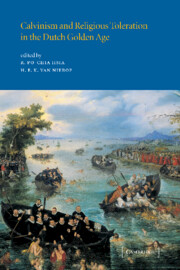Book contents
- Frontmatter
- Contents
- Notes on contributors
- 1 Introduction
- 2 ‘Dutch’ religious tolerance: celebration and revision
- 3 Religious toleration in the United Provinces: from ‘case’ to ‘model’
- 4 The bond of Christian piety: the individual practice of tolerance and intolerance in the Dutch Republic
- 5 Religious policies in the seventeenth-century Dutch Republic
- 6 Paying off the sheriff: strategies of Catholic toleration in Golden Age Holland
- 7 Sewing the bailiff in a blanket: Catholics and the law in Holland
- 8 Anabaptism and tolerance: possibilities and limitations
- 9 Jews and religious toleration in the Dutch Republic
- 10 Religious toleration and radical philosophy in the later Dutch Golden Age (1668–1710)
- 11 The politics of intolerance: citizenship and religion in the Dutch Republic (seventeenth to eighteenth centuries)
- Select bibliography
- Index
8 - Anabaptism and tolerance: possibilities and limitations
Published online by Cambridge University Press: 08 July 2009
- Frontmatter
- Contents
- Notes on contributors
- 1 Introduction
- 2 ‘Dutch’ religious tolerance: celebration and revision
- 3 Religious toleration in the United Provinces: from ‘case’ to ‘model’
- 4 The bond of Christian piety: the individual practice of tolerance and intolerance in the Dutch Republic
- 5 Religious policies in the seventeenth-century Dutch Republic
- 6 Paying off the sheriff: strategies of Catholic toleration in Golden Age Holland
- 7 Sewing the bailiff in a blanket: Catholics and the law in Holland
- 8 Anabaptism and tolerance: possibilities and limitations
- 9 Jews and religious toleration in the Dutch Republic
- 10 Religious toleration and radical philosophy in the later Dutch Golden Age (1668–1710)
- 11 The politics of intolerance: citizenship and religion in the Dutch Republic (seventeenth to eighteenth centuries)
- Select bibliography
- Index
Summary
One of the main victims of the religious clashes in sixteenth-century Europe was the group of Anabaptists. The great majority of the approximately 2,000 death sentences pronounced on the charge of heresy in the Netherlands during that century are related to Anabaptists. By rejecting infant baptism, refusing to take an oath, and their separation from the ‘world’ they had moved far away from mainstream Christianity. The shortlived kingdom of Munster (1534–5) had tainted the Anabaptist movement with the odium of violence and rebellion. Notwithstanding this, in the course of the century the following of Menno Simons had increased and had become an important movement which, at the end of the sixteenth century, in some regions like Friesland comprised about one-quarter of the population.
After the successful Revolt of the Netherlands against the Spanish king, the Dutch authorities had to cope with the presence of the Mennonites in society. Because of their large numbers the Mennonites could not be simply outlawed, while physical extinction was no option either. The authorities soon began following a policy of connivance, of grudgingly tolerating the Mennonites, to the regret of the ministers of the Reformed Church who demanded strict measures against Anabaptism. But although the Reformed Church had been given the status of a privileged Church in the Dutch Republic, it never became the State Church. Mennonites and other denominations like Jews and Lutherans were tacitly allowed – albeit with some restrictions – to profess their faith.
- Type
- Chapter
- Information
- Calvinism and Religious Toleration in the Dutch Golden Age , pp. 112 - 131Publisher: Cambridge University PressPrint publication year: 2002
- 2
- Cited by



